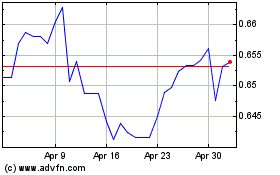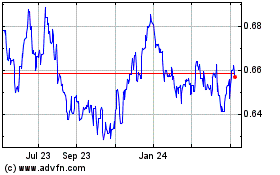Dollar Falls After Weak U.S. Personal Income And Outlays Data
June 25 2021 - 6:16AM
RTTF2
The U.S. dollar depreciated against its most major counterparts
in the European session on Friday, as the nation's personal income
slumped in May, easing fears over a faster tightening of monetary
policy by the U.S. Federal Reserve.
Data from the Commerce Department showed that personal income
slumped by 2.0 percent in May after plunging by 13.1 percent in
April. Economists had expected personal income to tumble by 2.5
percent.
Personal spending was virtually unchanged in May after climbing
by 0.9 percent in April. Personal spending was expected to rise by
0.4 percent.
A reading on inflation said to be preferred by the Federal
Reserve showed the annual rate of core consumer price growth
accelerated to 3.4 percent in May from 3.1 percent in April.
The currency was further weighed by stimulus optimism, after
President Joe Biden announced that the White House has reached an
infrastructure deal with U.S. Senators worth $579 billion.
The agreement proposes spending to rebuild roads, bridges and
other traditional infrastructure over the next five years.
The package is expected to generate "millions" of jobs and will
be funded through unused coronavirus aid money and returned state
jobless benefits.
The greenback showed mixed performance against its major peers
in the Asian session. While it fell against the euro and the pound,
it rose against the yen. Versus the franc, it held steady.
The greenback slipped to an 8-day low of 0.9151 against the
franc from Thursday's close of 0.9178. The greenback is seen
finding support around the 0.90 region.
Extending its early decline, the greenback touched a 3-day low
of 110.48 against the yen. The pair was worth 110.84 when it ended
deals on Thursday. On the downside, 108.00 is possibly seen as its
next support level.
Data from the Ministry of Internal Affairs and Communications
showed that overall consumer prices in Tokyo were flat on year in
June.
That exceeded expectations for a decline of 0.1 percent
following the 0.4 percent decline in May.
The greenback slid to a 2-day low of 1.1968 against the euro
from yesterday's close of 0.9178. The currency is likely to target
support around the 1.22 level.
Survey results from GfK showed that German consumer confidence
is set to improve in July as the country eases the lockdown
restrictions.
The forward-looking consumer sentiment index rose
more-than-expected to -0.3 in July from revised -6.9 in June. The
reading was the highest since August 2020. The expected score was
-4.0.
The greenback touched 8-day lows of 0.7617 against the aussie
and 0.7096 against the kiwi, down from Thursday's closing values of
0.7583 and 0.7057, respectively. The greenback may locate support
around 0.78 against the aussie and 0.72 against the kiwi.
The greenback reached as low as 1.2284 against the loonie,
compared to Thursday's New York session close of 1.2320. Immediate
support for the greenback is likely seen around the 1.21 level.
In contrast, the greenback remained higher against the pound, as
the latter fell after the Bank of England's caution about a
premature tightening. The currency was trading at 1.3891, compared
to yesterday's close of 1.3913.
Survey results from market research group GfK showed that UK
consumer sentiment remained unchanged in June.
The consumer confidence index held steady at -9.0 in June, while
it was forecast to rise to -7.0.
AUD vs US Dollar (FX:AUDUSD)
Forex Chart
From Mar 2024 to Apr 2024

AUD vs US Dollar (FX:AUDUSD)
Forex Chart
From Apr 2023 to Apr 2024
